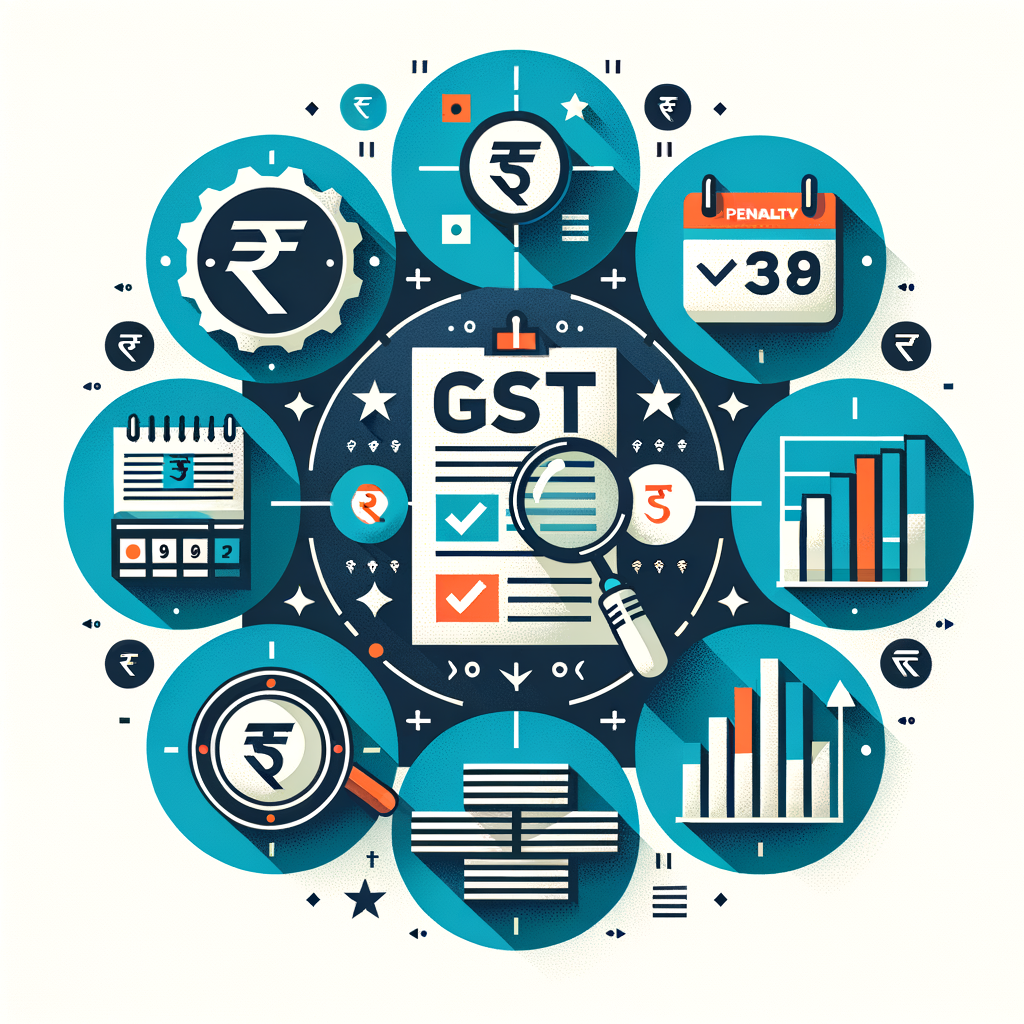How to Manage Late Filing Fees and Penalties for GST Returns
Missing a GST return deadline can be a stressful experience for any small business owner in India. The fear of accumulating fees and penalties is real, but it doesn’t have to be overwhelming. To effectively manage late filing fees, it’s essential to understand the system, know the consequences, and have a clear action plan. This guide is designed specifically for small business owners and freelancers who manage their own tax compliance. We will provide a clear, step-by-step roadmap to help you understand and manage these financial burdens effectively. Understanding the consequences and knowing the right steps can save you significant money and prevent potential legal trouble, turning a stressful situation into a manageable task. Learning how to manage late filing fees is a crucial part of financial discipline for your business.
Understanding the Consequences of a Missed GST Deadline
When you miss a GST return due date, a series of financial implications are triggered automatically by the GST system. These are not arbitrary fines but are calculated based on specific rules laid out in the CGST Act. The financial burden increases with each day of delay, making it crucial to act swiftly. For a business owner, these charges can impact cash flow and profitability if left unaddressed. Understanding the exact nature of these charges is the first step toward resolving the issue efficiently. It’s important to distinguish between the different types of charges you might face, as each has a different basis for calculation and implication for your business. These GST returns late filing consequences India are designed to encourage timely compliance, but knowing how they work is the first step toward effective management and mitigation.
The Difference: Late Fees vs. Penalties vs. Interest
Many taxpayers use the terms “late fee,” “interest,” and “penalty” interchangeably, but they are distinct concepts under the GST law. Knowing the difference is vital for correctly calculating your dues and taking the right corrective actions.
- Late Fee: This is a fixed, statutory charge levied for the simple act of not filing a GST return (like GSTR-3B or GSTR-1) by its due date. It is calculated on a per-day basis from the day after the due date until the return is filed. It is a charge for non-compliance with filing timelines, regardless of whether you have any tax to pay.
- Interest: This is a compensatory charge calculated on the amount of tax you have failed to pay on time. It is charged at a rate of 18% per annum. The calculation starts from the day after the due date of payment and continues until the date the outstanding tax is actually paid. The purpose of interest is to compensate the government for the delay in receiving its revenue.
- Penalty: This is a more severe financial punishment imposed for significant non-compliance, such as deliberate tax evasion, fraud, making false claims, or failing to register for GST when required. Penalties are not automatic. They are typically levied by a tax officer after issuing a show-cause notice and conducting a proper assessment. They are reserved for more serious offenses than a simple delay in filing.
How Late Fees Are Calculated Under the CGST Act
The GST system automatically calculates the late fee based on the number of days of delay and the type of return filed. The rates are specified under the CGST and SGST Acts and are applied equally.
- For Regular Returns (with transactions): If you have business transactions (sales or purchases) to report in your return, the late fee is calculated at ₹50 per day of delay. This is a combination of ₹25 per day under the CGST Act and ₹25 per day under the SGST Act. The maximum late fee that can be charged is capped at ₹5,000 per return.
- For Nil Returns (no transactions): If you had no business activity in a tax period, you must still file a “Nil” return. Failing to do so also attracts a late fee, albeit at a reduced rate. The charge for a late-filed Nil return is ₹20 per day of delay (₹10 under CGST + ₹10 under SGST). The maximum late fee for a Nil return is capped at ₹500 per return.
Important Note: The government can amend these rates and caps from time to time. It is always a good practice to verify the current applicable rates by referring to the latest notifications on the official GST portal.
Your Action Plan: How to Effectively Manage Late Filing Fees and File Pending Returns
Discovering you have pending GST returns can be daunting, but with a structured approach, you can clear your backlog and become compliant. The GST portal has a systematic process for this. Panicking or ignoring the problem will only make it more expensive. The key is to act methodically, addressing each component of your liability in the correct order to stop the financial clock from ticking and regain control over your compliance status. This action plan breaks down the process into clear, manageable steps that anyone can follow to resolve their pending GST filings.
Step 1: Calculate and Pay the Outstanding Tax Amount First
Your absolute first priority should be to stop the accumulation of interest. Interest, at 18% per annum, is calculated on the net tax liability that remains unpaid. The longer you delay this payment, the more interest you will owe. Therefore, before you even attempt to file the return, you must first calculate the tax you owe for the pending period (Output Tax – Input Tax Credit). Once you have this figure, log in to the GST portal and generate a challan (Form PMT-06) to deposit this amount into your electronic cash ledger. By paying the tax amount, you effectively stop the interest calculation from that day forward, even if you haven’t filed the return yet. This single step can save you a significant amount of money.
Step 2: File All Pending Returns in Chronological Order
The GST Network (GSTN) is designed to ensure sequential compliance. This means you cannot file a return for a later period if a return for an earlier period is still pending. For example, if you have missed filing your GSTR-3B for January and February, the system will not allow you to file the return for March until the previous two are submitted. You must follow a strict chronological order. Start with the oldest pending return. Gather all the necessary sales and purchase data for that month, prepare the return, and then proceed to the next month in sequence. This systematic approach ensures that your compliance record is corrected accurately and completely, leaving no gaps.
Step 3: Pay the Auto-Calculated Late Fee
Once you have paid the outstanding tax and are ready to file a specific pending return (e.g., GSTR-3B), the GST portal will automatically calculate the applicable late fee. This calculation is based on the number of days between the original due date and the date you are actually filing. The calculated late fee amount will be displayed on the screen and added to your electronic liability ledger. You must have sufficient balance in your electronic cash ledger to pay this late fee. If you have already paid your tax liability (as per Step 1), you may need to deposit an additional amount specifically for the late fee. The system will not let you submit the return until both the tax liability and the late fee for that period are fully paid. This is the final step in how to manage late filing fees penalties India for a specific return period and completes the filing process.
Prevention is Key: Late Fees Management Tips India
Clearing your pending returns is a reactive measure. The best long-term strategy is to build a system that prevents delays from happening in the first place. Proactive compliance not only saves you money on fees and interest but also frees up your mental energy to focus on growing your business. By implementing a few simple habits and organizational tools, you can transform GST compliance from a source of stress into a routine business function. These late fees management tips India are practical, easy to implement, and highly effective for small business owners and freelancers.
Maintain Meticulous Bookkeeping
The primary reason for delays in GST filing is often disorganized or incomplete financial records. When the deadline approaches, business owners find themselves scrambling to collect invoices, reconcile bank statements, and calculate tax liability. To avoid this last-minute rush, make bookkeeping a regular habit. Dedicate a specific time each week to update your sales and purchase registers. Use simple tools like a well-organized spreadsheet or affordable accounting software to keep track of every transaction as it happens. When your books are always up-to-date, filing your GST return becomes a simple matter of pulling a report, not a frantic data-hunting exercise, underscoring the importance of maintaining accurate accounting records for tax purposes.
Create a Compliance Calendar
Human memory is fallible, especially for busy entrepreneurs juggling multiple responsibilities. Do not rely on memory to track tax deadlines. Instead, create a dedicated compliance calendar. Use a digital tool like Google Calendar, Microsoft Outlook, or any simple calendar app on your phone. Mark all the important GST due dates for the entire year, using a helpful GST Return Filing Calendar 2025 as a reference.
- GSTR-1 (Details of Outward Supplies): 11th of the next month.
- GSTR-3B (Summary Return and Tax Payment): 20th of the next month (for most taxpayers).
Set multiple reminders for each deadline—for instance, one week before, three days before, and on the due date itself. This simple system acts as an effective safety net, ensuring you never miss a deadline again.
Always File a Nil Return
A very common and costly mistake among new business owners is assuming that no return is required if there were no business operations during a tax period. This is incorrect. Under the GST law, you are required to file a return for every tax period for which you are registered, regardless of business activity. If you had no sales, no purchases, and no tax liability, you must file a Nil return. Skipping it is treated the same as any other failure to file, and the system will start levying the late fee (at the reduced rate of ₹20 per day) until you file the Nil return. Following a guide on how to file GST returns online can simplify this process.
Consider Professional Assistance
Managing penalties for GST returns India can be complex and time-consuming. If you find yourself constantly struggling with deadlines, making errors in your returns, or spending too much time on compliance instead of your core business, it is a strong sign that you need professional help. An expert can ensure your returns are filed accurately and on time, every time. TaxRobo’s team of experts can handle all your GST filings, from data compilation to final submission, ensuring you remain 100% compliant and stress-free.
Conclusion
To recap, tackling GST delays involves a clear three-step process: paying the outstanding tax first to stop interest, filing all pending returns in chronological order, and finally paying the system-calculated late fee to complete the submission. While this action plan helps you fix existing issues, the real goal is prevention. Being proactive with meticulous bookkeeping, using a compliance calendar, and understanding your filing obligations (like filing Nil returns) are the best strategies to avoid these fees in the future. Don’t let compliance stress hurt your business. If you need assistance to manage late filing fees or want a reliable partner for your tax needs, contact TaxRobo today.
Frequently Asked Questions (FAQs)
1. What are the penalties for late filing GST returns in India for a Nil return?
A: The late fee for a Nil GST return is ₹20 per day (₹10 for CGST + ₹10 for SGST). This is subject to a maximum cap of ₹500 per return. A Nil return is mandatory even if you had no business transactions in a tax period.
2. Can I file my current GSTR-3B if I missed last month’s return?
A: No. The GST portal enforces a sequential filing rule. You must file all previous pending returns before the system will allow you to file the return for the current month. You need to start with the oldest pending return and work your way forward.
3. Does paying my outstanding tax stop the late fee calculation?
A: No, this is a common point of confusion. Paying your outstanding tax amount stops the interest from accumulating further. The late fee, which is a charge for the delay in filing the return itself, will continue to accrue daily until you successfully file that pending return.
4. Can GST late fees be waived?
A: Generally, the late fee is auto-calculated by the GST system and is mandatory to pay for filing a delayed return. However, the government periodically introduces GST Amnesty Schemes that offer a one-time waiver or a significant reduction in late fees for taxpayers who clear their pending returns within a specified window. It is important to keep an eye on official notifications on the GST portal for any such schemes.



